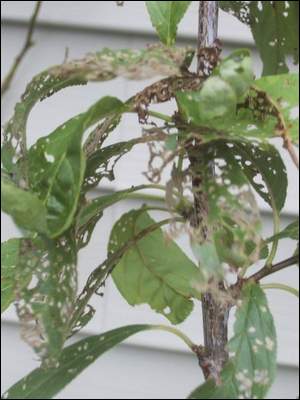Beetles launch annual attack; gardeners fight back
By Tanya Brown
Journal & Courier
July 12, 2006
 |
(By Reni Winter/Journal & Courier)
Young fruit trees after a few days of heavy beetle feeding |
Master gardener Esther Chosnek loves the beauty of summer gardens, but now that July is here, she's losing much of that beauty to a tiny winged intruder.
Japanese beetles, first introduced to the East Coast of the United States around 1920, have been making their way steadily westward ever since.
Today, Purdue Extension specialist Timothy Gibb says the Midwest likely has a higher concentration of the hungry bugs than any other region of the country.
With mid-July and August the prime season for the hard-shelled pests, gardeners like Chosnek and even farmers are trying to quell the tides, which can migrate to a yard from long distances.
"You just know you're going to lose some stuff every year, but Japanese beetles are so destructive. They just devoured my hollyhocks," said Chosnek, who lives on the west side of Tippecanoe County.
In fact, there isn't much Japanese beetles won't eat, said Gibb. From tree leaves to flowers to crops such as corn and soybeans, the beetles can consider almost anything a feast. But they do tend to favor certain types of plants more than others.
"They're difficult to control," said Gibb. "We can recommend chemicals to kill them, but that won't stop them from coming. Sometimes you need to consider looking for more tolerant plants."
To the beetles, most types of roses, linden trees, flowering fruit trees like crabapples and plums, shrub fruit such as raspberries and blueberries and corn and soybeans look and taste like lunch.
It's not uncommon to find one plant infested with hundreds of beetles, something about more than vanity when the pests threaten to destroy the silken tops of corn needed for reproduction and kernel production.
Gibb recommends using pesticides like Sevin spray or dust or pythroids, a class of chemicals usually labeled effective against the beetles.
Japanese beetles also regularly dine on turf grasses when in their grub stage in the ground, destroying golf course lawns, athletic fields and your neighbor's manicured front yard.
Chemicals such as Merit and Mach II can save grasses if applied before early August, but waiting later may be too late to save your grass, Gibb warns.
Determining why there are more of the beetles one season or another may have to do with the mildness of the winter combined with an absence of disease in the insect population, he said.
"I think the population is as high or higher than it was last year and last year was pretty bad," he said. "We also saw them go west of the Mississippi (river), into Arkansas and Oklahoma last year."
Monique Fontaine, another Master Gardener who lives in Lafayette, has resigned herself to the siege.
"If I'm really mad, I pick them off and put them in a bucket of soapy water, which will kill them, but you have to repeatedly do that because they're constantly showing up. My philosophy is let them eat. What are you going to do? They're here to stay."
Alternative plantings
Hoping to avoid Japanese beetle infestations? Timothy Gibb, Purdue Extension specialist, says while the pests eat more than 250 varieties of plants, they do tend to leave some alone.
Plants not on the beetle's lunch list include: Red maple, rebud and tulip poplar trees, pine and spruce trees, hosta and other bedding plants such as pansies, begonias, Dusty Miller and impatiens.
Beetle facts
For information on the history of and fight against Japanese beetles, try these helpful Web sites:
Or contact your local county's Extension office for tips and help. Find yours by heading to www.ces.purdue.edu and clicking "County offices" in the left hand column.
|